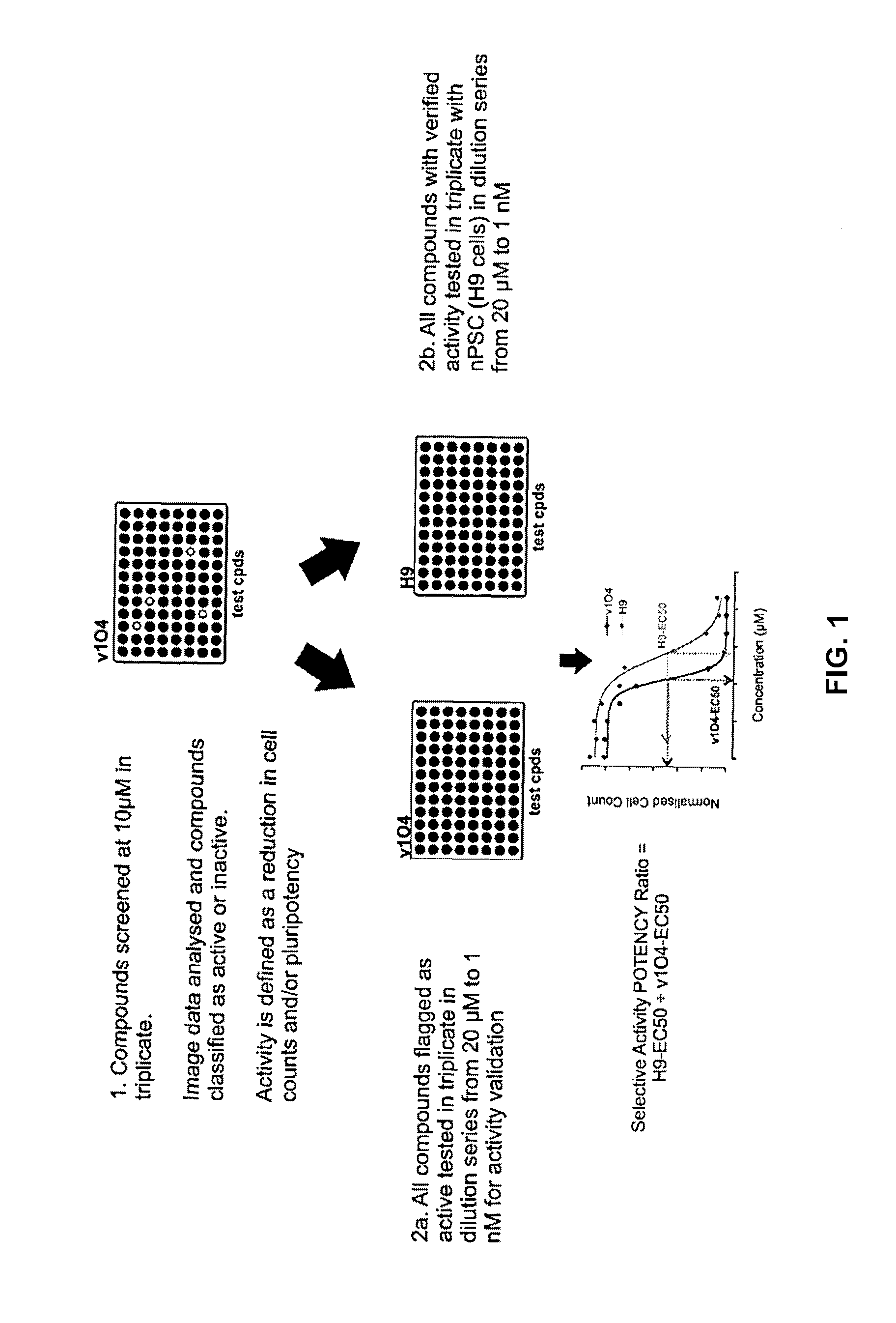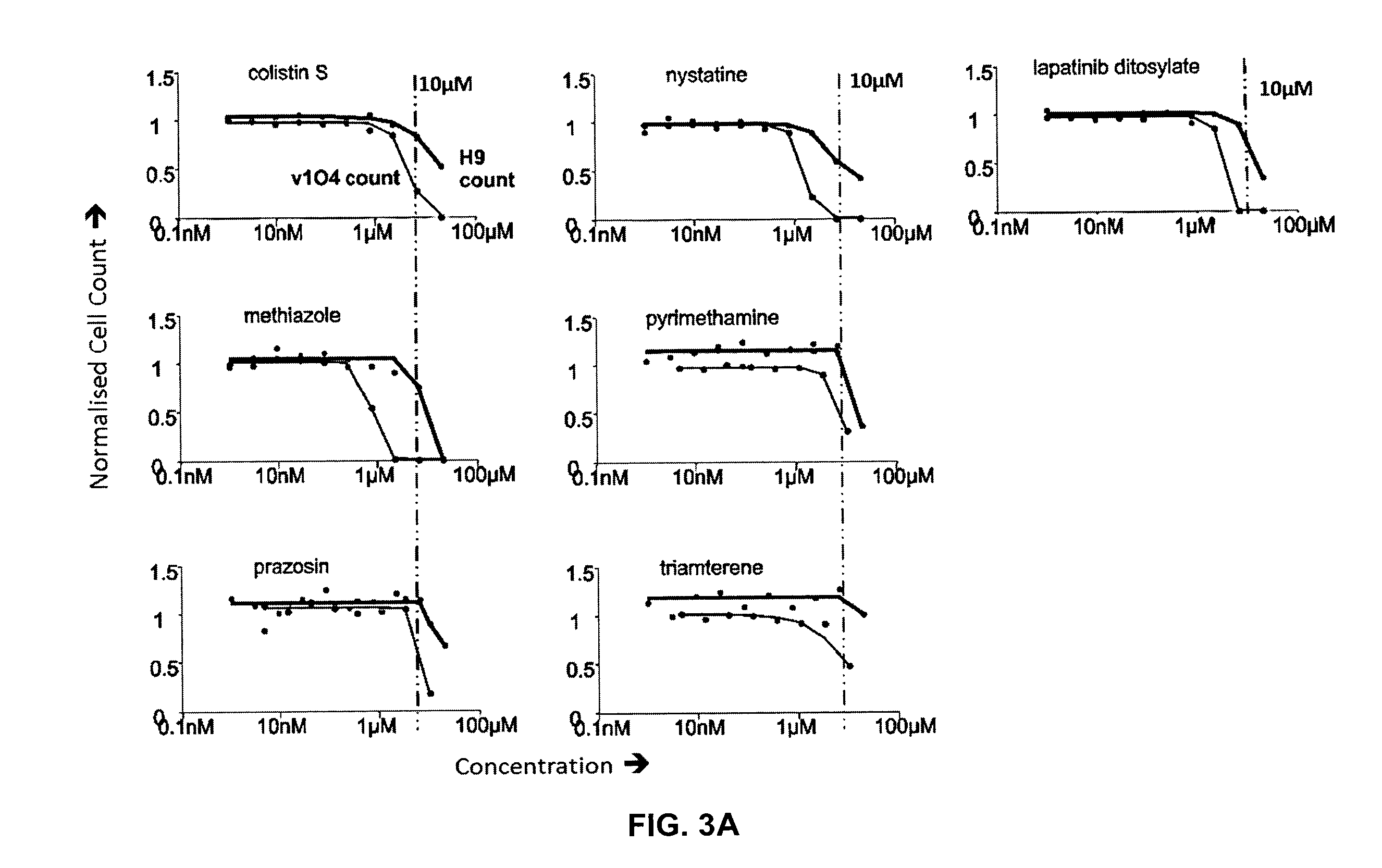Compounds and methods for selectively targeting cancer stem cells
a cancer stem cell and compound technology, applied in the field can solve the problems of ineffective human cscs, dose restriction, necessitating supportive treatment, and conventional chemotherapeutics, so as to reduce the proliferation of cancer stem cells, and induce the differentiation of cancer stem cells
- Summary
- Abstract
- Description
- Claims
- Application Information
AI Technical Summary
Benefits of technology
Problems solved by technology
Method used
Image
Examples
example 1
Identification and Characterization of Compounds that Selectively Target Cancer Stem Cells
[0045]The inventors have previously described a variant human pluripotent stem cell (hPSC) line that displays neoplastic features which include enhanced self-renewal and survival, along with aberrant block in terminal differentiation capacity in vitro and in vivo (Werbowetski-Ogilvie et al., 2009). Based on these similarities in functional properties to somatic CSCs, variant neoplastic stem cells are useful as a surrogate for somatic CSCs and are amenable for high content and high throughput screening in vitro. A screening platform was developed to identify small molecules that selectively target variant neoplastic stem cells whilst having little effect on normal hPSCs. This differential screening platform is capable of identifying potent candidate drugs that selectively target somatic CSCs while sparing healthy SC capacity.
[0046]Oct4 provides a reliable indicator of loss of self-renewing pluri...
example 2
Anti-Cancer Compounds are Rarely Anti-Cancer Stem Cell Compounds
[0054]The chemical libraries used for in the screening assays described herein contained compounds that are described as known or current anti-cancer therapeutics. Many of these anti-cancer therapeutics presumably have shown toxicity against cancer cell lines.
[0055]A MetaDrug search was performed for small molecule drugs with available structures that are used in treatment of human cancers (‘neoplasms’). This search found 167 such anti-cancer compounds from the combined NIH, PWK, TOCRIS and CCC libraries. These anti-cancer compounds were plotted as shown in FIG. 4 and only a small subset of them (5%) were identified as having activity against variant neoplastic stem cells (v1O4 cells). This suggests that the screening assay described herein is highly stringent or is identifying anti-cancer compounds in a unique manner. Furthermore, compounds previously identified as anti-cancer compounds are unlikely to be specific anti...
example 3
Some High Selective-Activity Compounds have Low p53 Stress Response Activation Activity
[0056]AML is characterized by neoplastic hematopoietic cells that are blocked in their ability to differentiate into mature cells. Similarly, variant neoplastic stem cells are also refractory to normal differentiation cues (See Werbowetski-Ogilive et at, 2009). Agents that can induce differentiation of neoplastic progenitor / stem cells represent a promising strategy for the treatment of certain cancers. Treatment of acute promyelocytic leukemia (APL) using all-trans retinoic acid (ATRA) and arsenic trioxide are exemplary applications of this strategy. These compounds are thought to eradicate the cancer stem cells that maintain the cancer by inducing differentiation.
[0057]To identify compounds demonstrated to have high-selectivity shown in FIG. 2 that are also efficient in inducing differentiation, treated variant neoplastic stem cells were analyzed for changes in p53-dependent cytotoxic stress resp...
PUM
| Property | Measurement | Unit |
|---|---|---|
| concentration | aaaaa | aaaaa |
| resistance | aaaaa | aaaaa |
| concentrations | aaaaa | aaaaa |
Abstract
Description
Claims
Application Information
 Login to View More
Login to View More - R&D
- Intellectual Property
- Life Sciences
- Materials
- Tech Scout
- Unparalleled Data Quality
- Higher Quality Content
- 60% Fewer Hallucinations
Browse by: Latest US Patents, China's latest patents, Technical Efficacy Thesaurus, Application Domain, Technology Topic, Popular Technical Reports.
© 2025 PatSnap. All rights reserved.Legal|Privacy policy|Modern Slavery Act Transparency Statement|Sitemap|About US| Contact US: help@patsnap.com



